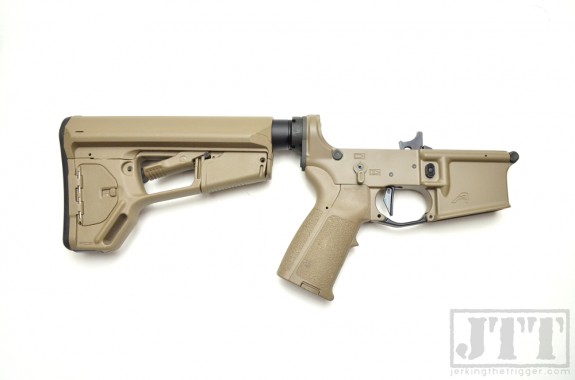The Geissele Automatics Super Dynamic series of triggers are some of the most visually distinctive triggers on the market due to their unique flat trigger bow. While it is striking, that flat trigger bow is not there for looks. It actually brings some interest functionality to an otherwise familiar trigger experience.
The Geissele Automatics SD-C (Super Dynamic Combat) is basically a flat trigger bow version of the venerable SSA trigger. Like the SSA, it is a non-adjustable, 2-stage trigger with a 4.5 pound pull weight (2 pound first stage and 2.5 pound second stage). The second stage has the same “carrot like break” of the SSA as opposed to more glass rod break of Geissele’s enhanced triggers like the SSA-E or SD-E. The quality of the SD-C is typical of the previous Geissele products that I have used which is to say it is excellent.
My focus for this review of the SD-C was to determine what, if any advantages or disadvantages the flat trigger bow offers. I have a good baseline of experience with the SSA, G2S, and the S2S (now discontinued and replaced by the G2S) that I drew upon in making the comparison.
The first thing that I noticed after installing the SD-C is that the flat trigger bow actually increased the trigger reach slightly but noticeably. Traditional curved triggers have a concave face that curls back toward the shooter at the center of the trigger bow. Obviously, a flat trigger bow lacks this curve which means that the center of the trigger bow is further from the back of grip and trigger reach is increased. I have averaged sized hands and this little bit of extra reach was perfect for promoting a proper, pad of the finger only, trigger engagement especially when using the large backstrap on a Magpul MIAD grip. The difference is enough to notice but probably not so much that users with small hands will have issues.
The flat trigger bow uses more than just a bit of extra reach to promote proper trigger finger placement. I have found that the flat trigger bow really just doesn’t feel right if you engage it with anything more than the pad of your finger. Curved triggers feel pretty natural for me with more trigger finger engagement – even up to the first knuckle. The flat trigger bow really feels unnatural if you give it any more engagement that just the pad of your finger.
The most interesting part of using a flat trigger bow is how uniform the face of the trigger feels under your trigger finger. Curved triggers funnel your finger to the center of the trigger but this flat trigger bow allows you to place your finger anywhere on the trigger face from top to bottom. This allows you to place your finger lower on the trigger, which increases your leverage and can actually have the effect of making the trigger feel a bit lighter than it is.
I found that there was basically no ramp up time on the SD-C. I expected that I would have to spend some time getting used to it but I found in both dry fire and live fire that it felt intuitive right away. The fundamentals of good trigger control still apply and the SD-C works well to reinforce these fundamentals with the shooter by promoting proper finger placement, providing a lighter break, and a positive reset.
If I had to pin down a disadvantage to the flat trigger face, I would say that the uniform trigger face feel provides less reference in regard to your finger placement. Curved triggers basically funnel your finger to the same spot for every trigger engagement. The flat trigger bow will require more discipline on the shooter’s part to ensure consistent trigger finger placement.
I am extremely pleased with this trigger. I purchased it for use in a precision AR-15 build and it has been serving well in that role. I regret not purchasing the more refined SD-E trigger for this build but that is my fault, not the trigger’s fault. The fact that it is serving well speaks to the versatility of this trigger. It can really bridge the gap from self-defense to competition and from a general purpose carbine to a precision carbine.
Check out the SD-C at Geissele.com or pick up an SD-C for your build at Brownells.com.






It doesnt only make it feel lighter, the pull is actually really lighter at the bottom due to the enhanced leverage created by a bigger distance from the trigger pivot pin. simple physics.
Hence the leverage comment in the review.
Nice review. Maybe the Tricon would do the trick and give you somewhere in between the flat and the curved?